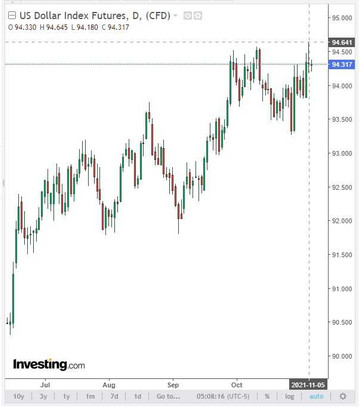"Inflation has accelerated, but its underlying indicator remains low. Inflation pressures remain lower than in many other countries, not least due to modest wage increases in Australia", RBA Governor Philip Lowe said after last week's central bank meeting.
As you know, at this meeting, the RBA kept the key rate at a record low of 0.10%, where it has been since the end of 2020, also announcing that it will no longer manage the yield curve. This monetary policy instrument is used by central banks to keep government bond yields (by purchasing them) from rising above a certain level. The purchase of government bonds by the central bank is, in fact, a quantitative easing instrument, which, in turn, reduces the value of the national currency.
"With other market interest rates shifting in response to the likelihood of accelerating inflation and lower unemployment, the effectiveness of yield targeting to lower the overall interest rate structure has weakened", Lowe said.
Thus, the refusal to target government bond yields in the current environment can contribute to its growth and, as a rule, to the strengthening of the national currency.
However, the Australian dollar fell sharply last week after the RBA meeting. Probably, market participants were expecting tougher decisions from it and focused on the RBA's statement, which indicated a tendency to keep the interest rate at the current level. Lowe said the central bank is willing to be patient with the interest rate hike, in part because it is unknown how long supply chain disruptions will last.
The RBA also said it would continue to buy A $ 4 billion in government bonds a week at least until mid-February, and the key condition for a rate hike (sufficient wage and employment growth) is unlikely to emerge soon. It appears that the announcement by RBA executives that the key interest rate could be raised until 2024 was not considered strong enough by market participants to ensure further strengthening of the AUD.
At the same time, despite the fact that the Australian economy continues to recover from the first recession in 30 years due to the pandemic, periodic outbreaks of the spread of the delta strain of coronavirus in certain states of the country can create new problems, despite the fact that more than 80% of the adult population relatively densely populated southeastern states of the country have been vaccinated with two doses of the Covid-19 vaccine. At the same time, external factors may also restrain the country's economic recovery. The slowdown in economic growth in China led to a sharp decline in the price of iron ore - the main commodity of Australian exports (China accounts for more than 40% of exports from Australia).
Today the AUD / USD pair is attempting to recover from last week's crash. However, this slight increase in AUD / USD can be attributed to the weakness of the US dollar so far.
It, in turn, is declining, despite the strong monthly report of the US Department of Labor, published last Friday. As follows from this report, in October, the growth in the number of jobs outside of agriculture in the United States amounted to +531 thousand, and unemployment fell to 4.6% from 4.8% in September. In addition, the number of non-farm jobs in the United States rose by 312,000 in September, up from the 194,000 previously reported.
At the time of this posting, DXY futures are traded in a tight range, close to 94.31, the levels reached in mid-October and 13 months ago.

At the same time, Fed leaders at the last Wednesday meeting approved a plan to curtail the asset purchase program (this process will begin in November and should end by June next year). The Fed will cut bond purchases by 15 billion in November and another 15 billion in December. In the opinion of its management, such a reduction in the volume of acquired assets "is likely to be appropriate every month".
At the same time, the leaders of the FRS left interest rates at the same level, close to zero values (the target range of the federal funds rate remained the same, 0.00% -0.25%). The conclusion made by market participants is that the American central bank will not rush to raise interest rates: the labor market has not fully recovered yet, and the Fed leaders still consider increased inflation to be a temporary phenomenon.
And this will still be a deterrent for the USD from its faster strengthening.
Today the publication of important macro statistics in the economic calendar is not planned. However, market participants will pay attention to Fed Chairman Powell's speech, which will start at 15:30 (GMT). His unexpected statements on the prospects for the Fed's monetary policy may cause increased volatility in financial markets. If he does not touch upon the issues of monetary policy, then the reaction to his speech will be weak.
At the same time, market participants who follow the dynamics of the AUD and the AUD / USD pair will wait for the publication on Thursday (at 00:30 GMT) of data from the Australian labor market. According to the forecast, in October the number of employed Australian citizens increased by 50,000 (after falling by -138,000 in September, -146,300 in August, an increase of +2200 in July, +29100 in June, +115200 in May, a fall of -30600 in April, by -264100 in May 2020 and an increase of +29100 in January 2021), while unemployment increased by 0.1%, to 4.7%. Overall, the numbers don't look strong.
The leaders of the RBA have repeatedly stated that, in addition to the situation in international trade, the Australian economy and the central bank's monetary policy plans are influenced by indicators of the level of household debt and expenditures, the growth of workers' salaries, as well as the state of the country's labor market. In the opinion of the RBA management, an unemployment rate of 4.5% or lower is required to raise wages and accelerate inflation to the target range.
AUD is unlikely to react positively to the publication of data from the country's labor market. If the values of the indicators turn out to be worse than forecast, then the Australian dollar may significantly decline in the short term. Better-than-expected data will strengthen AUD in the short term.





